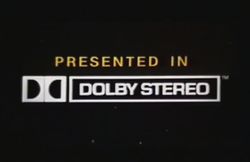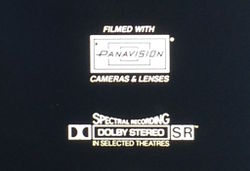| Welcome to Sprocket School! This project is maintained by volunteer editors. Learn more about how this works. |
Dolby A: Difference between revisions
Jump to navigation
Jump to search
No edit summary |
|||
| Line 7: | Line 7: | ||
* Some (but not all) films with Dolby A tracks will display the words "Stereo" on the edges of the film [[leader]]. | * Some (but not all) films with Dolby A tracks will display the words "Stereo" on the edges of the film [[leader]]. | ||
* A Dolby A track played in Dolby SR will usually sound harsh or blown out | * A Dolby A track played in Dolby SR will usually sound harsh or blown out | ||
<gallery widths=250px heights=250px> | |||
File:Dolby stereo.jpg|Dolby Stereo logo. | |||
File: Dolby stereo SR .JPG| Dolby Spectral Recording logo (SR) | |||
</gallery> | |||
[[Category:Sound formats]] | [[Category:Sound formats]] | ||
[[Category:Sound]] | [[Category:Sound]] | ||
Revision as of 18:12, 10 December 2016
Dolby A is a four channel sound format – left, center, right and surround. It was in use from approximately 1975 to 1986, when it was largely replaced by Dolby SR.
Dolby A vs. Dolby SR
Dolby A is difficult to distinguish from Dolby SR by sight. Here are some tips on telling them apart:
- Many studio films made between 1975 and 1985 will have Dolby A tracks.
- Some (but not all) films with Dolby A tracks will display the word "Dolby" - or "Dolby Stereo" rather than "Dolby SR" - with the Dolby logo in the end credits.
- Some (but not all) films with Dolby A tracks will display the words "Stereo" on the edges of the film leader.
- A Dolby A track played in Dolby SR will usually sound harsh or blown out
-
Dolby Stereo logo.
-
Dolby Spectral Recording logo (SR)

